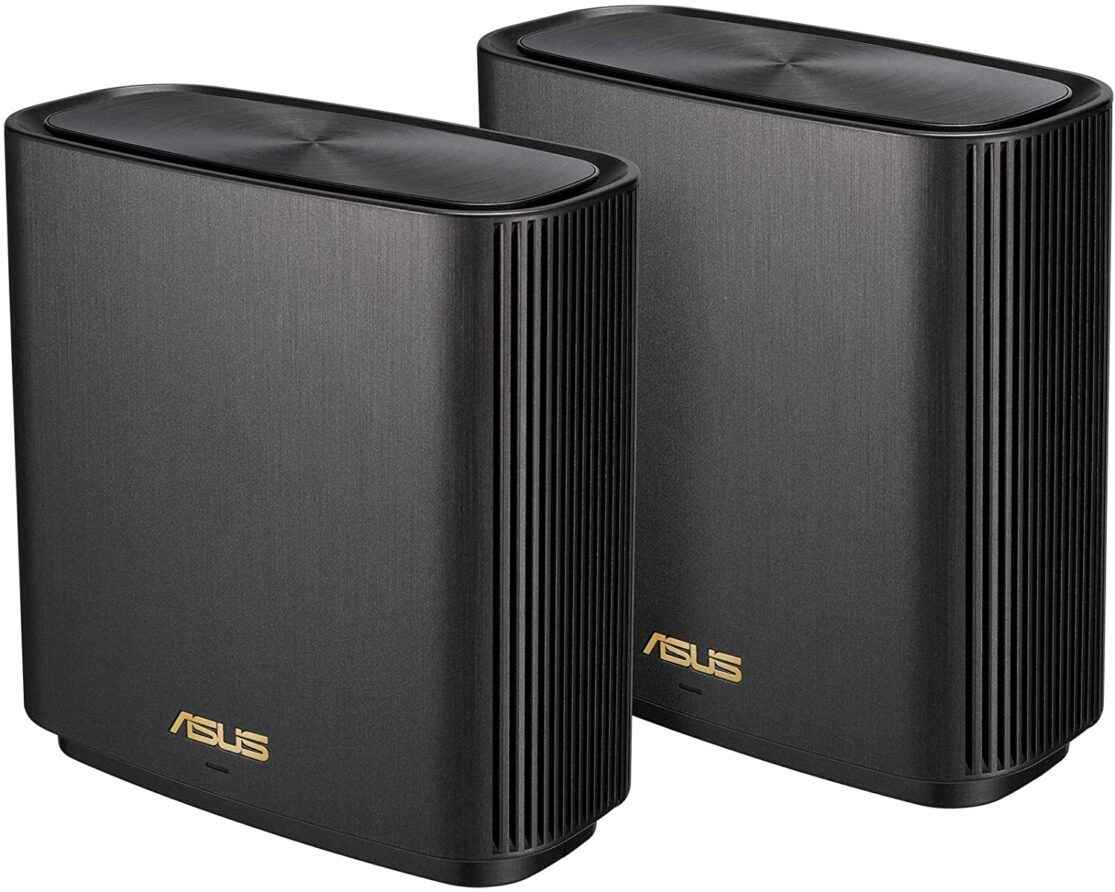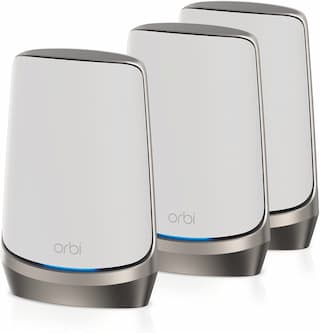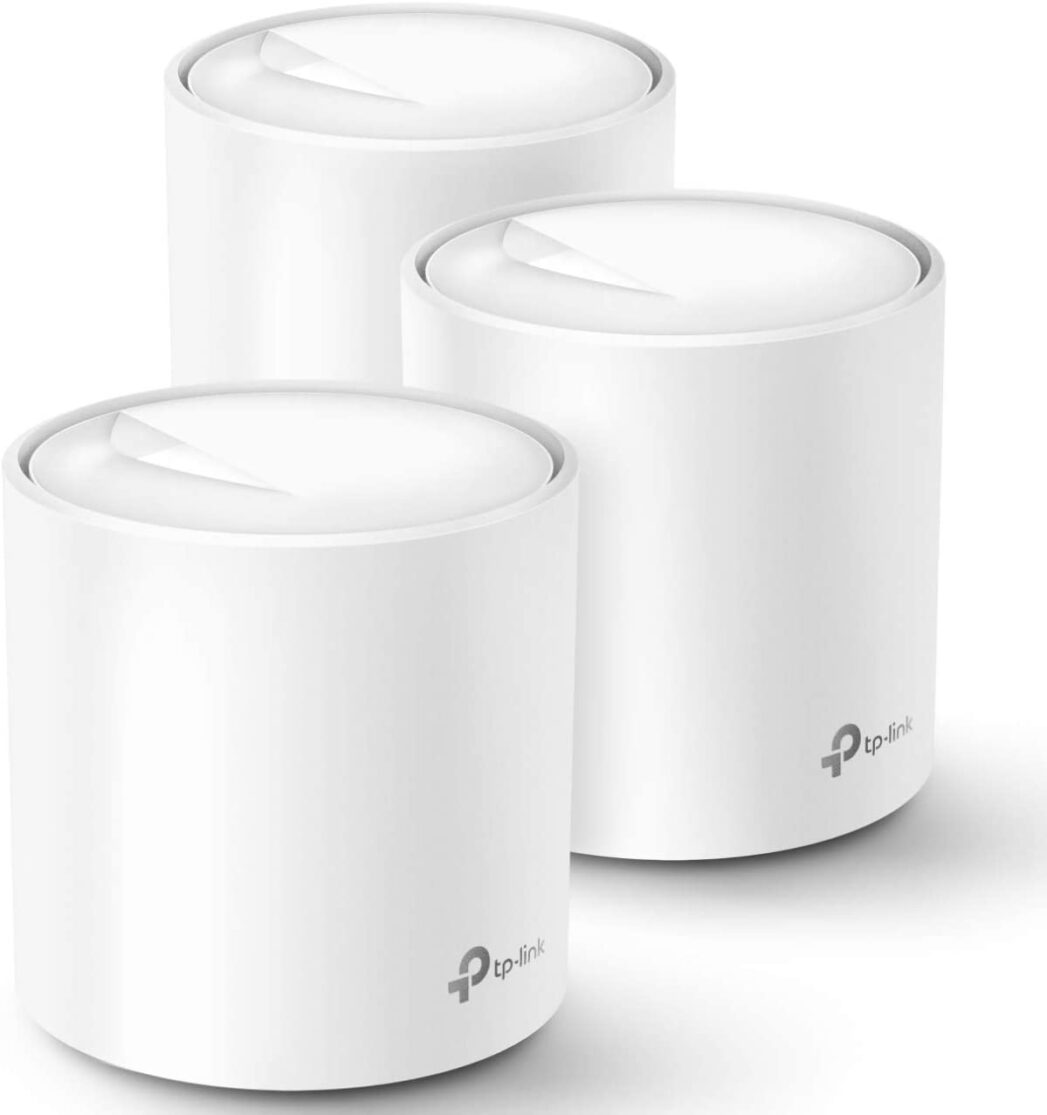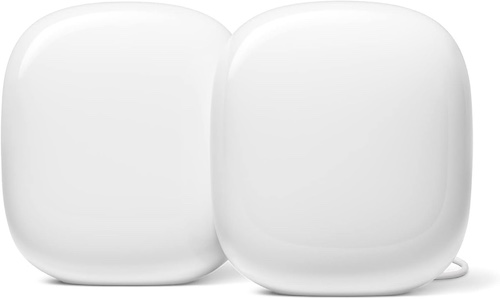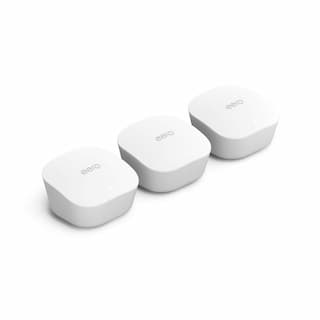Mesh Wi-Fi systems are the best way to spread Wi-Fi coverage throughout your home. With a mesh system, you can eliminate dead spots and have consistently faster Wi-Fi speeds than you would with a Wi-Fi router alone.
Our top recommendation is the ASUS ZenWiFi AX (XT8), which offers fast Wi-Fi 6 speeds at a more affordable price than the top-performing NETGEAR Orbi RBKE963. But if you don’t have gigabit internet at home, the TP-Link Deco X20 should take care of you just fine.
Read on to compare these options to brand-name favorites like the Google Nest WiFi Pro and eero systems.
Compare mesh Wi-Fi systems head to head
| Product | Amazon Price | Wi-Fi standard | Recommended speed | Band support | Details |
|---|---|---|---|---|---|
| ASUS ZenWiFi AX (XT8) | $349.99 | Wi-Fi 6 | Up to 4 Gbps | Tri-band | View on Amazon |
| NETGEAR Orbi RBKE963 | $1,499.99 | Wi-Fi 6E | Up to 5 Gbps | Quad-band | View on Amazon |
| TP-Link Deco X20 | $149.99 | Wi-Fi 6 | Up to 900 Mbps | Dual-band | View on Amazon |
| Google Nest WiFi Pro | $199.00 | Wi-Fi 6E | Up to 5,400 Mbps | Tri-band | View on Amazon |
| eero | $199.00 | Wi-Fi 6 | Up to 500 Mbps | Dual-band | View on Amazon |
*Amazon prices effective 11/29/23 at 11:46 a.m. PT. See full disclaimer.
If you pay for gigabit internet and want a mesh Wi-Fi system, the ASUS ZenWiFi AX (XT8) will help you reach those speeds throughout your whole home. The NETGEAR Orbi RBKE963 takes things to the next level, with 9,000 square feet of Wi-Fi coverage, a more powerful processor, and new Wi-Fi 6E technology.
But if you don’t have gigabit internet, go for the more affordable TP-Link Deco X20. The dual-band mesh setup isn’t quite as fast as tri-band or quad-band, but the Wi-Fi 6 technology helps to make up for that.
If you’re new to mesh Wi-Fi and worried about setup, Google’s Nest WiFi Pro system offers a simple user experience. Plus, its satellites come with Google Assistant for a true smart home experience.
And bargain hunters take note—the eero mesh Wi-Fi system offers wider coverage than much of the competition. We recommend waiting for Prime Day for the best deal on the original eero, eero Pro, or eero 6 systems.
Best mesh Wi-Fi systems in depth
Let’s dig into what makes each of these mesh Wi-Fi systems special so you can choose the right one for your home.
Editor’s choice—ASUS ZenWiFi AX (XT8)
*Amazon prices effective 11/29/23 at 11:46 a.m. PT. See full disclaimer.
Pros
- Easy setup with app
- Lifetime built-in security
- Parental controls
Cons
- Big price tag
The ASUS ZenWiFi AX (XT8) hits all the notes we like in a mesh Wi-Fi system: Wi-Fi 6, tri-band support, high Wi-Fi speed capabilities, and plenty of square foot coverage. ASUS’s reliable reputation doesn’t hurt either.
Even if you’re not a computer expert, the ASUS ZenWiFi AX makes it easy to keep your home and family safe and connected.
Plus, this mesh router system won’t take up much space since it needs only two devices to cover 5,500 square feet. You can even add a third router to cover up to 7,500 square feet.
Go for the ASUS ZenWiFi AX (XT8) if you want a high-performing Wi-Fi network and more control over your internet connection.
Best for performance—NETGEAR Orbi RBKE963
*Amazon prices effective 11/29/23 at 11:46 a.m. PT. See full disclaimer.
Pros
- Includes top-of-the-line technology
- Supports the fastest internet speeds
Cons
- Requires annual fee for security
- Requires annual fee for parental controls
The NETGEAR Orbi 960 series offers top-of-the-line tech in every regard. It’s got the best of everything a mesh systems needs to cover a massive square foot area with the fastest Wi-Fi available.
This router isn’t everyone’s taste, though—the massive price tag should tell you that. Plus, you’ll need plenty of cash handy to pay the annual subscription fees for NETGEAR’s security ($99.99 a year) and parental control services ($69.99 a year).
So go for this mesh system only if you have an enormous home (it covers up to 9,000 square feet) and a multi-gig internet plan.
Wondering where you’d even find a multi-gigabit internet plan? Check out fiber internet providers like AT&T Fiber, Xfinity, and Frontier Fiber—AT&T Fiber, in particular, offers up to 5 Gbps download and upload speeds.
Best value—TP-Link Deco X20
*Amazon prices effective 11/29/23 at 11:46 a.m. PT. See full disclaimer.
Pros
- Supports average home Wi-Fi speeds
- Provides Wi-Fi 6 speeds at affordable price
Cons
- More than three times slower than the ASUS ZenWiFi AX (XT8)
If you don’t see the point in getting a Wi-Fi 5 device (ye ole 802.11ac) when Wi-Fi 6 is available, but you also don’t want to break the bank, the TP-Link Deco X20 will give you the most bang for your buck.
Just keep in mind the TP-Link Deco X20 is 3.7 times slower than the ASUS ZenWiFi AX, and it has only two bands compared to the ZenWiFi AX’s three. We recommend connecting your units through Ethernet cords to get the most out of this mesh system’s possible speeds.
Even if you don’t decide on a wired connection for your TP-Link Deco X20 system, you should still get good speeds—though they may not reach the maximum speeds you’re paying for. Some internet in your home’s Wi-Fi dead spots is better than none, right?
Best for simplicity—Google Nest WiFi Pro
*Amazon prices effective 11/29/23 at 11:46 a.m. PT. See full disclaimer.
Pros
- Simple app-assisted setup
- Cute marshmallow look
Cons
- Higher cost than similar devices
If you need a mesh Wi-Fi system, but all this technical jargon is freaking you out, don’t worry—Google has you covered.
Google’s Nest WiFi Pro mesh system is designed for easy setup in under ten minutes, with step-by-step instructions on a smartphone app. Everything comes integrated, so no high-tech specs will distract you from using this mesh Wi-Fi network.
As with other mesh systems, the Nest WiFi Pro has multiple router units to spread Wi-Fi coverage over your home. The router units also come with four different color options and include Ethernet ports alongside Wi-Fi 6E support for faster and more reliable Wi-Fi coverage.
Choose the Google Nest Wifi system instead of picking up a copy of Mesh Wi-Fi Systems for Dummies. This mesh router system is cute, and it works great without you having to study up.
Best bargain—eero
*Amazon prices effective 11/29/23 at 11:46 a.m. PT. See full disclaimer.
Pros
- Affordable mesh Wi-Fi system
- Great deals on Prime Day
Cons
- Limited Wi-Fi speeds
If it takes a real steal of a deal to get you excited about a mesh Wi-Fi system, Amazon’s eero system is the one you’ve been waiting for.
This system doesn’t have much going for it beyond its recognizable brand name and low price. It runs on Wi-Fi 6 and covers almost 1,000 square feet less than our other picks. And you won’t want this device if you pay your internet provider for more than 500 Mbps.
But there are only about ten reliable mesh Wi-Fi systems that run less than $200 for a complete set. And we like that each eero unit comes with Ethernet ports (the Wi-Fi 6 version eero 6 has Ethernet ports only on the central hub).
And because it’s an Amazon system, Amazon will occasionally offer drastic discounts on the eero and/or its other eero systems: eero 6, eero 6+, eero Pro 6, and eero Pro 6E. Keep your nose to the ground for big savings, or wait for the next Prime Day.
What to look for in a mesh Wi-Fi system
If you’re rearing to head out into the brave new world of mesh Wi-Fi systems and find an option of your own, make sure it has the right Wi-Fi standards, square-foot coverage, and the number of bands.
Wireless standard
In 2019, Wi-Fi 6 (802.11ax) debuted as the new Wi-Fi standard with speeds up to 10 Gbps (theoretically, in a lab, and with optimal conditions). That’s about 30% faster than the previous standard, Wi-Fi 5 (802.11ac), could ever dream of being.
Some mesh routers on the market are still Wi-Fi 5, but new mesh systems tend to use Wi-Fi 6 tech, or even the new Wi-Fi 6E, which uses the 6 gigahertz (GHz) frequency band to offer even faster speeds over a short range.
If you love high speeds and want to be ready for any advances in internet network technology, there are plenty of superfast Wi-Fi 6 mesh systems out there right now. Try the ASUS ZenWiFi AX (XT8) on for size.
But if you’re a pragmatist or don’t want to upgrade your router, Wi-Fi 5 still supports the average download speeds that internet service providers offer today. Just check that the router you buy works with the internet speeds you already pay for.
Wi-Fi coverage
Wi-Fi square-foot coverage is the whole reason you’d want a mesh Wi-Fi system in the first place. If your house is sprawling, oddly shaped, has a lot of levels, or has brick, metal, or thick walls—mesh networking will make your life easier.
When buying a mesh Wi-Fi system, consider how much ground each mesh router or mesh satellite can cover.
Some mesh systems offer a lot of coverage with just two units. But mesh systems that come in three packs provide more flexibility for arranging devices throughout an oddly shaped or three-story home.
If you have your heart set on a specific mesh router, but the pre-built packs can’t cover your square footage, don’t despair. Most brands sell additional satellites, which you can add to your mesh network to extend the range.
Band support
Two Wi-Fi frequency bands can do the job fine for traditional routers. When trying to connect to your internet, you’ve probably run into these bands—one Wi-Fi connection with the router’s typical name and one with that adds 5G afterward.
The Wi-Fi connection with no number in the title is a 2.4 GHz frequency, which can support speeds only up to 600 Mbps, but works great as a dedicated connection for your smart home devices.
The connection with the 5G in the name is a 5 GHz frequency, which supports speeds up to 1,300 Mbps on high-performing Wi-Fi 5 routers. The 5 GHz connection works best for your phone, TV, and computer.
Tri-band routers take your connection one step further by adding a 6 GHz or second 5 GHz frequency band. The elusive quad-band router will have a mix, usually one 2.4 GHz, two 5 GHz, and one 6 GHz band.
This additional 5.0 GHz band plays an important role in mesh systems because it is dedicated solely to sending your internet data between the satellites and routers in your house without interfering with your current connection’s speed.
While dual-band routers can work just fine for slower internet plans, your tri-band router will be perfect for supporting gigabit mesh Wi-Fi. If you have gigabit speeds (1,000 Mbps) in your large home, make sure you go for a tri-band mesh system to get all the speeds you’re paying for.
Is a mesh Wi-Fi system worth it?
Mesh Wi-Fi systems are a valuable complement to your Wi-Fi router, especially if your home is oddly-shaped or you’re struggling to transmit Wi-Fi signals through thick interior walls.
We recommend the ASUS ZenWiFi AX (XT8) and NETGEAR Orbi RBKE963 systems for gigabit internet speeds. Go for the TP-Link Deco X20 system if you want the most bang for your buck, the Google Nest Wifi system if you’re nervous about mesh wifi, and the eero system if you don’t want to drop a lot of cash.
Best of mesh systems FAQ
Are Wi-Fi mesh systems worth it?
If your home is over 3,000 square feet, you get dead spots from thick walls, or you have an unusual floor plan, mesh systems will significantly improve your home internet experience.
However, mesh systems are costly, and we don’t recommend forking out all that cash when another solution will work just as well. Try a range extender if you need your Wi-Fi signal to reach just a bit farther.
What is the best Wi-Fi 6 mesh system?
The ASUS ZenWiFi AX (XT8) is the best Wi-Fi 6 mesh system, thanks to its fast speeds, strong Wi-Fi signal, and easy-to-use app. It’s also less expensive than many other Wi-Fi 6 mesh systems.
Is a mesh system better than a router?
While a powerful Wi-Fi router can be a good solution for some large homes, mesh systems offer more customization options for Wi-Fi coverage. But the Wi-Fi speeds vary for both Wi-Fi solutions, so be sure your device supports the speeds you pay your internet provider for.
Does a mesh system replace a modem?
Mesh systems replace routers, not modems. Check out our modem vs. router guide to learn the difference between the two devices.
Methodology
For this article, we compared 55 mesh Wi-Fi systems on price, coverage, wireless standard, and band support.
We selected our winners based on individual use cases to better serve readers who wanted top performance, affordability, or ease of use.
We based our recommendations on max download speed plans for the mesh systems on a combination of brand recommendations and theoretical speeds adjusted for real-world performance.
For more on our process, see our How We Rank page.
Amazon Disclaimer
CableTV.com utilizes paid Amazon links. Product prices and availability are accurate as of the date/time indicated and are subject to change. Any price and availability information displayed on Amazon.com at the time of purchase will apply to the purchase of this product.

